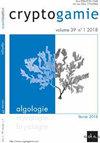DNA Barcoding Sheds Light on Novel Records in the Tunisian Red Algal Flora
IF 1.5
4区 生物学
Q3 MARINE & FRESHWATER BIOLOGY
引用次数: 14
Abstract
ABSTRACT Tunisia is located at a key position in the Mediterranean Sea where it constitutes a transitional area between the eastern and western basins benefitting from rich habitat diversity. The most recent inventory of marine macrophytes dated back to 1987 with an update in 1995, however these inventories were performed with identification based on morphological observations, which can be misleading for many seaweed species. To the best of our knowledge, this is the first study of the Tunisian macroalgal flora using DNA barcoding methods. Our target was to carry out a survey of macroalgae, to reveal cryptic species and allochthonous introductions, and to identify taxa with problematic taxonomy. COI-5P sequence analysis resolved 26 genetic species, including two new reports and three alien species. Of the remaining taxa, several displayed cryptic diversity relative to species reported from the Mediterranean versus from other geographical regions with taxonomic and nomenclature updates provided where possible. The aim of the present paper was to provide a DNA barcode-assisted floristic list of florideophycean algae collected along the Tunisian coast.DNA条形码揭示了突尼斯红藻区系的新记录
突尼斯位于地中海的关键位置,它构成了东西方盆地之间的过渡区域,受益于丰富的栖息地多样性。最近的海洋大型植物清查可追溯到1987年,并于1995年进行了一次更新,但这些清查是基于形态学观察进行的鉴定,这可能对许多海藻物种产生误导。据我们所知,这是第一次使用DNA条形码方法对突尼斯大藻群进行研究。我们的目标是开展大型藻类的调查,揭示隐种和外来引种,并查明分类上存在问题的分类群。COI-5P序列分析确定了26个遗传种,包括2个新报道种和3个外来种。在剩余的分类群中,有几个分类群与地中海和其他地理区域报告的物种相比表现出隐晦的多样性,并尽可能提供了分类和命名法的更新。本论文的目的是提供一个DNA条形码辅助的植物区系清单,收集沿突尼斯海岸的藻类。
本文章由计算机程序翻译,如有差异,请以英文原文为准。
求助全文
约1分钟内获得全文
求助全文
来源期刊

Cryptogamie Algologie
生物-海洋与淡水生物学
CiteScore
2.60
自引率
7.70%
发文量
11
审稿时长
>12 weeks
期刊介绍:
Cryptogamie is a fast-track and peer-reviewed journal of international scope publishing in English only. It accepts original papers and review articles on the taxonomy, biology and ecology of all cryptogams. An issue of Cryptogamie may be devoted to a single topic, under the responsibility of guest editor(s). All articles published in Cryptogamie are compliant with the different nomenclatural codes. A copyright assignment will be signed by the authors before publication.
Cryptogamie, Algologie accepts articles on systematics as well as ecology and evolution of any kind of algae (including Cyanobacteria).
 求助内容:
求助内容: 应助结果提醒方式:
应助结果提醒方式:


